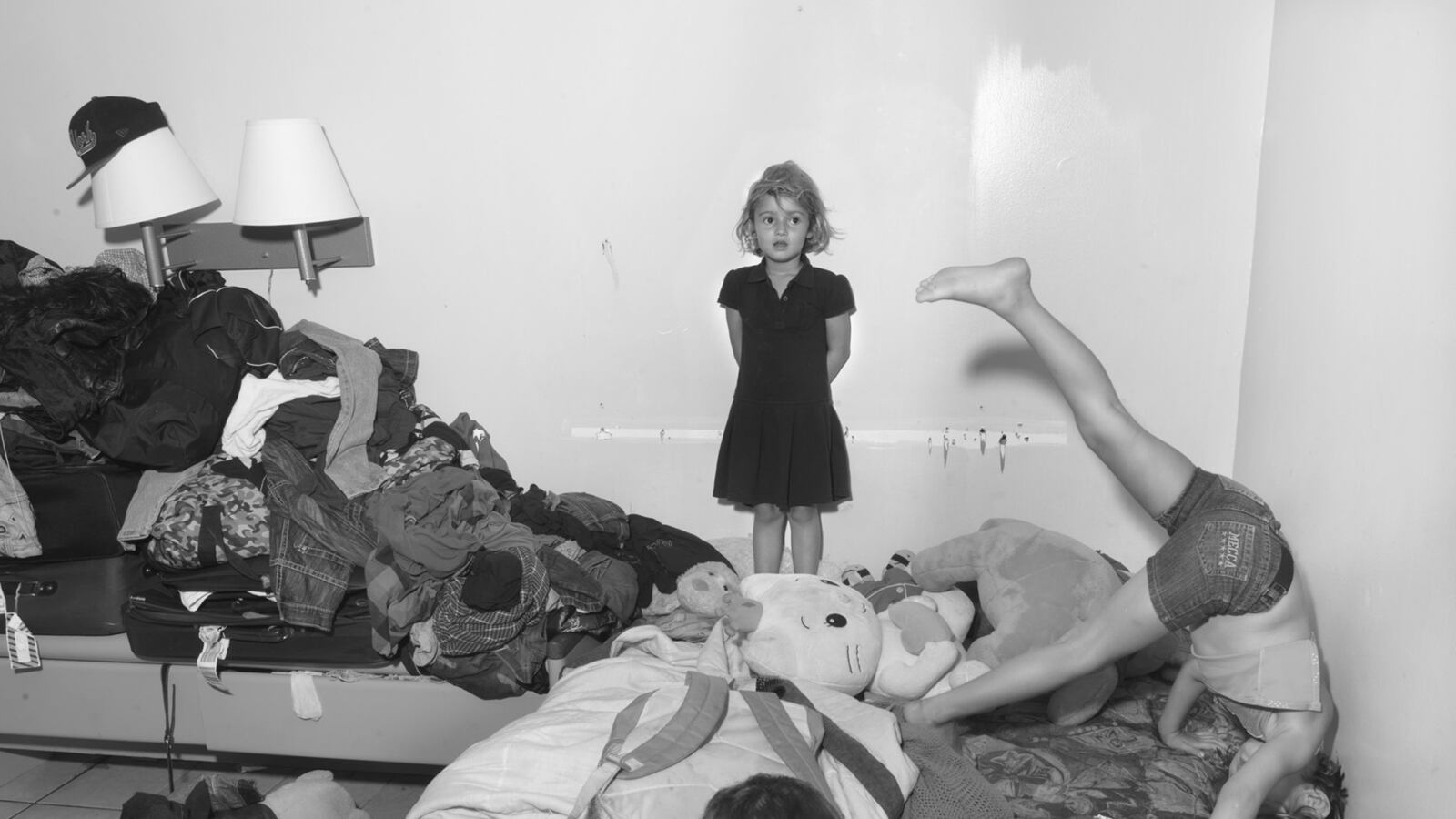Encouraging nods and “yups” are dotted throughout my time with Alec Soth. While I am the one who is supposed to be interviewing the American photographer who’s won an array of awards and honors, including the Guggenheim Fellowship in 2013, Soth likes to solicit others’ thoughts and opinions. His easy Midwestern demeanor radiates out of him as he walks me through the trendy Sean Kelly Gallery on the west side of Manhattan.
Part of that inquisitiveness is specifically tied to this latest exhibition, Songbook, which features 25 photographs without a single caption or word of explanation. (The exhibition is also opening with variations at the Fraenkel Gallery in San Francisco on February 5 and the Weinstein Gallery (in Minneapolis on February 20.) It is also published as a book.

It seems initially that there are no titles or text with the photographs because the exhibition is not yet complete, but their absence is part of the experience. “It’s about removing that back story and letting them [viewers] recreate the world a bit,” Soth tells me. “I wanted pictures that held their own without a back story. It’s about letting people make their own stories.”
Each photograph in the exhibition has a wonderful way of making your brain instantly start churning through the visual details to come up with a history, a narrative behind the image.
The photographs are all in black and white and quite large, some as big as 59 ¼ by 77 ¼ inches, which invites the viewer to focus on seemingly innocuous details: a mismatched pair of socks in a shot of two high school football players in Michigan running into practice, a pair of six six-and-half heels with worn soles, the mounted, generic double lamp of a generic worn motel.
These are the kinds of details that Soth loves, the small markers that can reveal so much of the economic, social, romantic, racial, geographical background. He shows me a photograph of two small children, one standing and one somersaulting, and a baby on a bed with piles of clothes exploding out of worn suitcases.
In the chaos, he points to that mounted double lamp and talks about how the lamp reveals the setting is a fairly run-down motel. From there, you put pieces together: small children, piles of suitcases, dilapidated motel. There’s suddenly a stinging narrative forming in my head, and I can picture so many other images from their day-to-day lives.
It’s the ability to “read” these pictures, as he calls it, and fill in the histories that draws Soth to American subjects time and again in his work. “Someone was telling me how I need to photograph in China—and I have—but I can’t read everything that way,” he says. “I love being able to read the nuances of the American landscape.”
By no means has Soth exclusively focused on images of America, but his reputation has been built by projects that use the land and the people as a his subject.
Soth’s 2004 show and book Sleeping by the Mississippi, a collection of landscapes, portraits, and interiors from a road trip along the Mississippi River, helped earn him a spot in the Whitney Biennial. As if seemingly overnight, it brought him international art world recognition.
Since graduating from Sarah Lawrence College in New York with a general liberal arts degree, Soth had been living in Minnesota quietly building a name in his home state while at times holding various “day jobs” that were connected to photography, if not the work he wanted.
“In college, I interned at galleries, and it felt unattainable to make a living in that sphere, so I thought of returning to Minnesota and pursuing my work for the long-term and doing something else for a living,” he says. He worked in darkrooms and did photo assisting before taking a job as a photographer for the Lillie Suburban newspapers, a chain with weekly issues for different Minnesota suburbs. He then got a job at the Minnesota Art Institute where he did inhouse work and documented various collections.
How did Soth’s father and mother—a lawyer and an interior decorator—feel about his choice to pursue photograph? “The thing about me is it was not like I was a Bohemian wanderer type. I always had a job and was always responsible. They were just low-paying jobs,” he says with a little laugh. “But yeah, they were surprisingly supportive.”
To say Soth is not a “Bohemian wanderer” is a fairly grand understatement. He’s been married to his wife for nearly 20 years after meeting in high school, and they have two children, a 12-year-old daughter and an eight-year-old son. “There will never be a biography about me. It’d be pretty tedious,” he says, sort of jokingly, but sort of not.
“It’s a really healthy thing,” he says of choosing to live in Minnesota. “There’s this whirlwind activity in New York, which reminds me why I stay away from it. There’s a sort of feeling of competition and sort of climbing the ladder of the art world. All of that is distracting from actually making art.”
He admits that it is “fun and intoxicating,” but he’s not here to party it up. “I would find it hard to focus on the work itself if I were around that all the time.”
Soth grew up in Cohasset, Minnesota in a farmhouse that, oddly enough, has since been bought by the artist formerly known as Prince (he tore it down as part of a massive chunk of property he bought in the area—“I’m not angry, but it has special memories,” says Soth). Growing up by a woods, Soth first developed a fascination with forests and open spaces. “It played an important part in my creative life. That’s where I created pretend friends and stuff like that,” he says.
It was also growing up in Minnesota when he first began learning about photography from his teacher, Bill Hardy, who he still keeps in touch with to this day and works with on educational projects. “He’s a remarkable guy, and he would really encourage us to get out of the classroom and take walks and explore. I remember his first lesson was without a camera. He would just have us walk with cardboard mats with windows cut-out and we’d look through them,” he recalls. “It was a good lesson, but I didn’t take to it originally.”
Not until he went to college did Soth say he really connected with photography. “I think it was a mixture of a little more maturity—and I discovered some photographers, particularly Robert Adams and his book Summer Nights,” says Soth. “Having that moment of being inspired by something changed it [photography] for me.”
Adams’ black-and-white shots of the American landscape and images of ordinary people caught in a moment can clearly be seen in Songbook.
Soth cites other American photographers and movements as shaping his perspective, especially for this latest exhibition. “This work is definitely partially inspired by Dorothea Lange, Walker Evans,” he tells me.
The Depression-era influence is not surprising, considering that many of Soth’s subjects are on the lower rung of the socioeconomic ladder. While one of his projects, The Last Days of W., specifically focused on scenes of American socioeconomic fatigue, his subjects in general tend to be more lower and middle-income people. “I like access and rich people are hard to access,” he tells me with a laugh. “I would have to jump through a million hoops to get through a country club. It’s not that I didn’t try, but I am definitely attracted to open people.”
Loneliness is another quality in subjects that attracts Soth. In fact, his collection Broken Manual was entirely focused on Americans who strove to live off the grid as survivalists and hermits and in other extremely solitary ways.
“I’m definitely attracted to individuals, loneliness,” he tells me as we look at a photograph of an older man standing with his back turned towards a wall of drawers with worn hand-written titles, his palm facing outward. Soth tells me it was taken in the backroom of a magic shop in Michigan.
There is something depressing and mysterious about the image, perhaps it’s his weary posture which takes up a good chunk of the frame. “This is my kind of picture, my kind of man,” he tells me.
But he wrings his hands a bit, so to speak, when I ask him more about the subjects to which he gravitates. “It’s such a difficult question. It’s like you’re looking across a crowded bar, and you’re attracted to that one person, and you’re asked why. I don’t know—because she reminds me of what my mom is like, because it’s genetic, all sorts of different things,” he says. “It would take years of analysis to sort it all out, but I know it when I see it.”
Despite the eerie, somber quality to many of his photographs, Soth has a refreshingly, relatively positive view of American society. In one photograph, two perspiring young men, one black and one white, clutch each other in a field.
Soth tells me it was shot at a camp for the blind in Georgia. Though he said the region was still very racially segregated, he loved this image of the two depending on each other. “It’s a blatant metaphor, but it’s so true,” he says.
Against another wall in Sean Kelly, there are two photos side-by-side, at a prom in Ohio. Crowds of sweating teenagers from the waist to shoulder up overtake both.
Since their actual clothes aren’t in the focus and, as with every other photo in the collection, it’s in black-and-white, the image looks like it could be from a school dance in the past two or three decades—except in one photo a same-sex male couple is in the foreground, and in the other, an interracial couple.
“I am photographing the world as it is. I am not staging it, but it is shot in a way to evoke the past,” he says, explaining his efforts at a modern nostalgia are purposeful. “It’s a realization that 60 years ago, the world wasn’t black-and white. People used to swear. There were sex crimes. There were all sorts of horrible things like there are now. We idealize the past—and we’re cynical about the present.”
Perhaps even more overpowering than the nostalgic quality of Soth’s photos is the intimacy with his subjects, which is striking throughout his work, not just in his most recent Songbook. How does he simply interrupt teenagers running late to football practice or peek into a young couple returning from a Kentucky Derby party?
“I get so little resistance. People are surprisingly open to attention,” he tells me, though he also stresses he doesn’t tend to have deep, in-depth conversations with them. “I’ve always downplayed the idea I have some incredible relationship with the subject. It’s not like I’m having some deep conversation, nor do I want that. I want to experience the person the way I experience the image, where you don’t have the back story.”
Songbook actually began when Soth asked his friend Brad Zeller, who is a reporter, to join him on a “fake news trip” as a birthday present. Soth would photograph and leave the interviewing part to Zeller.
Instead of the photographer being dropped in to illustrate what the editorial side had already done, the two were able to work together. They began releasing their work under a self-printed newspaper, The LBM Dispatch, through Soth’s independent publishing company, Little Brown Mushroom.
Based in St. Paul, Minnesota, Little Brown Mushroom publishes not only Soth’s work and that of other artists and writers, but has started organizing workshops and classes.
In fact, when we talk about Little Brown Mushroom’s interactive programs, Soth gets more excited and proud than at any other point of our interviews. The group ran the July 2013 Summer Camp for Socially Awkward Storytellers weekend, which brought artists from around the world to Minnesota to workshop new and innovative ways to tell stories.
“The workshop we ran was life-changing,” says Soth, especially since he prefers traveling less and getting to spend more time with his family. “It was great having people to Minnesota.”
Now, Soth says he is focused on Little Brown Mushroom’s Winnebago Workshop, a camp he will set up this summer out of his studio in St. Paul. Sponsored by a grant from the Knight Foundation, the Winnebago Workshop will work with young artists ages 16 to 18 in the mobile classroom of a Winnebago to learn visual storytelling techniques. At the end of the workshop, the students will screen their stories on the outside of the Winnebago.
More than any personal collection or future foray into movies (“I don’t have a dying hunger for it”), Soth is excited about teaching, inspired by his own mentor, Bill Hardy.
“I never believed that my art work was a force for good in any way. I don’t think it’s a force for evil, but I don’t think it’s a humanitarian act,” he says. “I’m getting really interested in how that high school teacher changed my life. I want to do that for someone else.”






